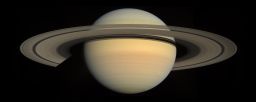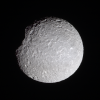Emily Lakdawalla • Dec 21, 2009
Planetary Society Advent Calendar for December 21: Miranda
Miranda is the one moon of Uranus for which we have very good images from Voyager 2, and that was a stroke of luck, because low-resolution shots of all of Uranus' moons would have told us that it was, geologically speaking, the most dramatic of the five biggest ones. When scientists first saw these photos, they theorized that the lumpy moon had been smashed into bits in an earlier big impact, then those bits, large and small, re-coalesced into the moon we see now. That explanation is no longer the favorite. Now people think that Miranda is a moon that began to differentiate, but froze before the differentiation process could complete.
This is a beautiful mosaic of the Voyager 2 closest-approach images put together by Ted Stryk. Unlike all the images I've posted so far, this one is not in color. Voyager 2's color data on Miranda is really pretty awful, so it's probably better to enjoy this detailed view in black and white. Miranda's one of the moons transitional in shape between round globes and lumpy rocks, and, at 470 kilometers in diameter, it's bigger than Mimas and Proteus but smaller than Enceladus. I love the weird racetracks of Miranda's coronae, and the line of tall, steep mountains marching off toward the terminator on the right side of this view.

By "differentiation," planetary scientists refer to the way that larger solar system bodies tend to separate into distinct layers, with their densest material in the center and their least dense material at the outside. The process would set up a circulation pattern inside the moon, with downwelling plumes of dense material (e.g. rock) and upwelling plumes of less dense material (e.g. ice). But this can only work if the moon's interior can flow. Stuff can flow while technically solid, given enough time, but if stuff gets too cold, it will quit flowing. Miranda was warm enough at the outset, but got too cold to finish the job, so we're left with bizarre looking surface features over the sites of upwelling and/or downwelling.
Each day in December I'm posting a new global shot of a solar system body, processed by an amateur. Go to the blog homepage to open the most recent door in the planetary advent calendar!
Support our core enterprises
Your support powers our mission to explore worlds, find life, and defend Earth. You make all the difference when you make a gift. Give today!
Donate

 Explore Worlds
Explore Worlds Find Life
Find Life Defend Earth
Defend Earth






















